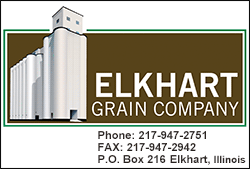|
 Hartman said, "Farmland sales have recently been around $12,500
per acre and are now around $11,000. The crop profit per acre can
vary, but profit margins and interest rates affect land value." He
said the University of Illinois 2016 crop budget, operator and land
return amounts, are around $260 an acre. Hartman said, "Farmland sales have recently been around $12,500
per acre and are now around $11,000. The crop profit per acre can
vary, but profit margins and interest rates affect land value." He
said the University of Illinois 2016 crop budget, operator and land
return amounts, are around $260 an acre.
Hartman notes, "Land sales are a bit softer than six months to a
year ago due to lower profit margins and lower commodity prices. The
2015 farm income was down considerably." He said most farming
operations rent more than they own through crop share or cash rent.
Hartman also said "Land prices have softened due to the lower
commodity prices and profit margins, so people are proceeding
cautiously. Expenses have not come down much and profit margins are
still very tight. Interest rates are very reasonable, though not as
low as they were two years ago. At the current time, rates are three
percent below what they were in 2008."
This downward trend was predicted last fall. Surveys done during
fall 2015 by the Illinois Society of Professional Farm Managers and
Rural Appraisers showed, "Prices being paid for farmland across
Illinois are continuing a softening trend that is following prices
being paid for commodities, with decreases of between two and seven
percent, depending on the quality of farmland and location."
 In farmdocdaily's "2016 Farmland Price Outlook," Gary D. Schnitkey,
Bruce Sherrick, and Todd Kuethe from University of Illinois at
Urbana-Champaign's Department of Agricultural and Consumer
Economics, also predicted a continued decrease in prices. They said,
"Farmland prices in Illinois decreased modestly during the first
half of 2015, and it appears that downward pressures are likely to
continue into 2016."
Land for sale vs. land being sold
Hartman said more land is on the market now than six months ago.
Most land is sold from December through April. Land sales were down
a couple of years ago, but are slowly increasing.
In his recent article "Scorching Hot Illinois Farmland Auctions
Continue" Ben Potter indicates that there have been many investors
and farmers "vigorously" bidding at recent farmland auctions. In
that same article, R.D. Schrader, president of Schrader Real Estate
and Auction Company said, "Nobody can predict what’s ahead, but the
reality we’re seeing on the ground is that farmers and investors
alike see farmland as a good long-term investment.”
Size of the acreage being sold and bought
Hartman said several tracts of 200 acres or more are for sale at
this time. For example, Lincoln College has some large tracts of
land for sale around the county. Most parcels are being sold in at
least 20 acre plots.
When looking at who is buying acreage and whether it is farmers with
small, medium, or large farms, Hartman said, "The range is all over
the board depending on the size of the tract and where it is
located. Most farmers are using it for crop production." He also
said more of the acreage is planted with corn than beans. Farmers
may occasionally rotate what they plant with three years corn, then
one year soybeans, but some just plant corn from year-to-year.
[to top of second column] |

Reasons for selling farms
Hartman said some are selling to settle an estate. Others may be
selling due to low profit margins, which have caused many farmers to
lose money.
Small farms are becoming part of big farms
When asked whether small farms are becoming part of bigger farms,
Greg Conrady, who farms near Hartsburg, said, "Yes, it is inevitable
now and what [nearly] everyone is pushing toward. There are fewer
family farms now." He said some farmers buy ground when they inherit
money.
Emden farmer Jim Klokkenga said there are not as many small farms
around the area anymore. He said the trend is for farmers to own at
least 900 to 1,000 acres, and some of the big farms are getting even
bigger. Klokkenga said most need at least 2,000 acres to be able to
support a family. It is driven by economics and tight margins, so it
is difficult to support yourself unless you have enough acres.
Hartman said some of the farmers in Logan County who own bigger
farms have over 5,000 acres, but the vast majority have around 500
to 2,000 acres.
Uses for the land
Most of the land being purchased is used for crop production.
Hartman said Logan County is mostly corn and soybean operations with
little or no livestock. There are some families with livestock
operations though.
The lower profit margins and lower commodity prices will likely
continue to affect land sales and farmland values, so it is
important to watch the trends closely.

|